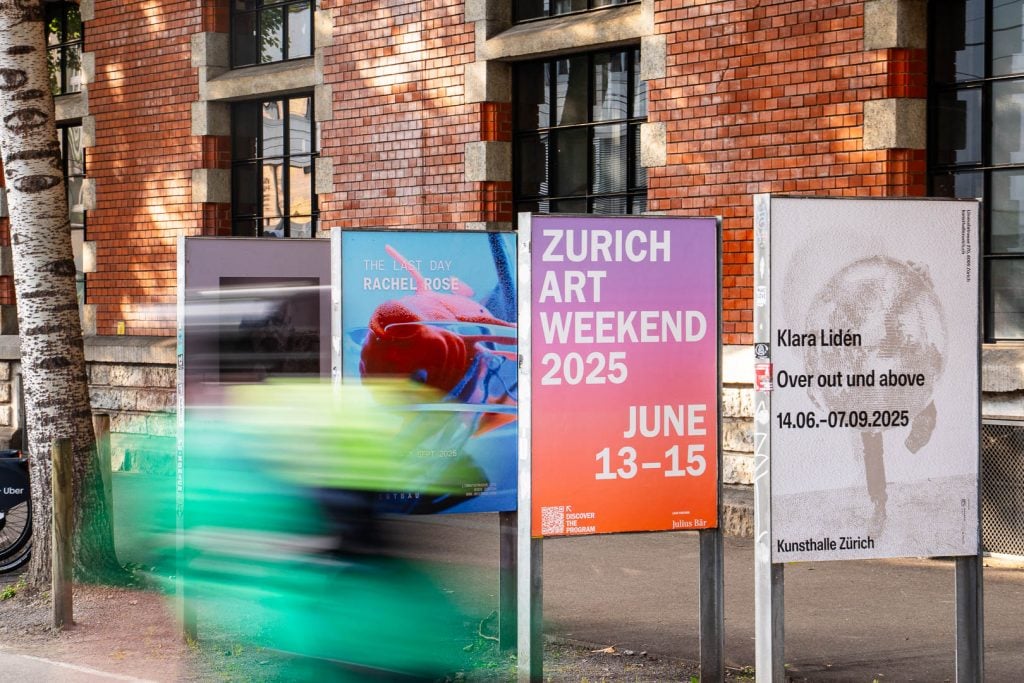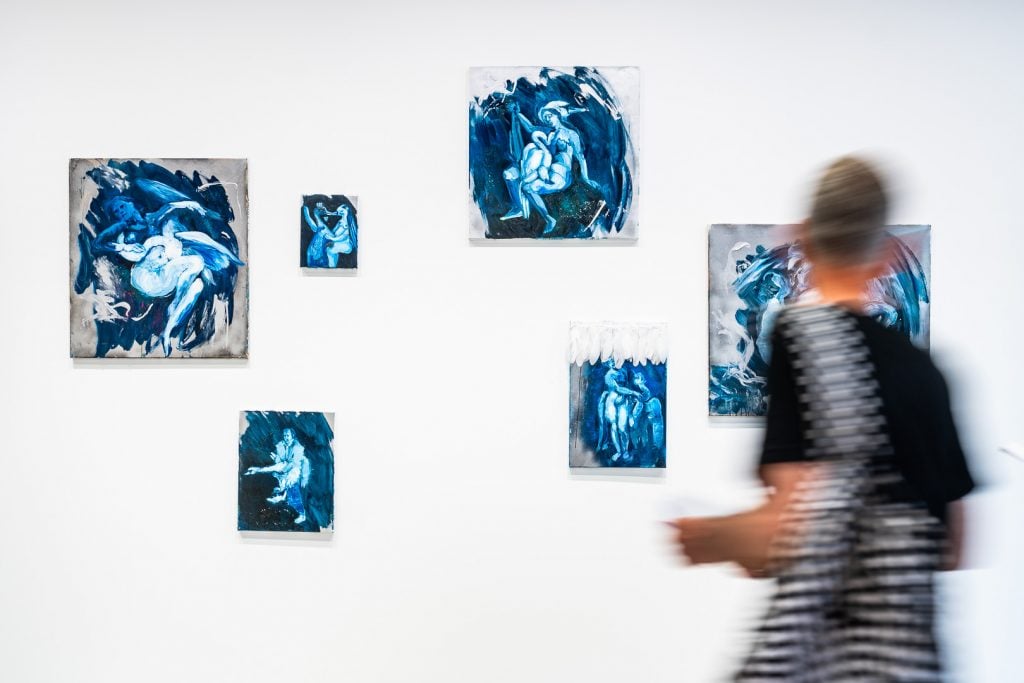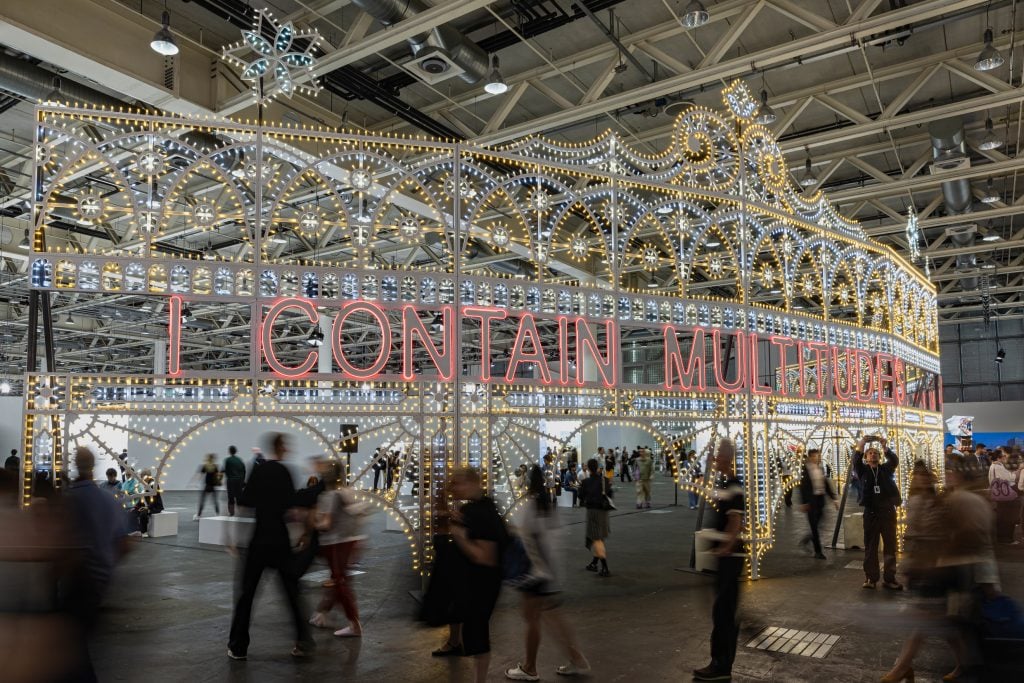The soaring temperatures across Switzerland this week matched Maurice Mielcarek’s passion for art. At Zurich Art Weekend, just ahead of Art Basel, the Zurich-based collector was seen animatedly chatting with friends and introducing them to New York artist Travis Boyer, who was in town for his solo show at Galerie Peter Kilchmann.
The evening embodied Mielcarek’s idea of “good art karma.” The 43-year-old began collecting Boyer’s velvet paintings two years ago and has since been spreading his enthusiasm to others. One young collector in his circle, who had purchased a velvet pineapple painting on Mielcarek’s recommendation, finally had the chance to meet Boyer in person.
“It’s incredible to have a group of like-minded friends,” said Mielcarek of his collecting cohort. “We lift each other up and grow together, and you are rewarded for doing good deeds.”
Mielcarek, who works in finance, is part of a widening circle of younger collectors who take a slower, more intentional approach to collecting. This generation of buyers, mostly in their 30s and 40s, is driven more by lasting engagement than by speculation or financial investment. They are connected by a shared spirit of curiosity, dialogue, and knowledge exchange. Rather than rushing to buy, they take time to research artists and galleries, often building long-term relationships before making a purchase. For them, collecting is just one way to support an artist; equally important is advocating for the artist’s vision, values, and community.

Zurich Art Weekend 2025. Courtesy of Zurich Art Weekend.
Discover, Don’t Follow
Mielcarek said he looks for artists of his generation or 10 years younger. “I want to discover, not follow,” he said, noting that he first fell in love with art when his father took him to Documenta as a child. He prefers conceptual or narrative-driven works over purely aesthetically pleasing ones. He likes Boyer’s work, for example, not only for the artist’s technique but also the symbolism of the objects the artist paint on the velvets. He also collects Berlin-based French-Swiss artist Julian Charrière (b. 1987), whose practice explores the intersection between the environment and cultural history. Charrière is currently the star of a solo exhibition at the Museum Tinguely in Basel.
Mielcarek said he is willing to wait a year or two to see how an artist evolves before committing to a purchase. He is now cataloguing a personal collection of more than 200 works, built over the past decade. How the galleries support and grow their artists’ careers also matters, he added.

Travis Boyer’s (b. 1979) velvet paintings draw collectors attention. Courtesy of Galerie Peter Kilchmann.
Collectors like Mielcarek are fueling activity at the lower end of the art market, where works are priced under $50,000. It’s a segment that’s showing resilience even amid a global contraction. Fine art sales dropped 27.3 percent year-over-year in 2024, according to the Artnet Intelligence Report, with declines across all price sectors. Total fine art sales by value in the $10,000-to-$100,000 range shrank by 13.8 percent, while works priced under $10,000 were down 6.3 percent.
The volume of transactions in this segment, however, are up, suggesting more people are buying at lower price points. Total auction sales of lots under $50,000 rose 2 percent and sales of lots under $20,000 grew 3 percent. The Art Basel and UBS Art Market Report 2025 similarly noted that smaller dealers with annual turnover under $250,000 saw a 17 percent increase in sales last year.
Not in a Rush
Gallerists are seeing this shift towards values-driven “slow buying” firsthand. “People are becoming more interested in process, materials, and the reasoning behind the work,” said Niina Ulfsak, associate director of London’s Arcadia Missa—which is making its Art Basel debut this year—and co-founder of the independent gallery Galerina, which is exhibiting at the satellite fair Liste. She’s observed a growing group of young, first-time collectors in London who don’t come from collecting families but are buying art simply because they love it.

Galerie Urs Meile’s opening of new Zurich space during Zurich Art Weekend. Courtesy of Zurich Art Weekend.
One such collector is 30-year-old Ayo Shonibare, who returned to Basel for his fourth art week this year. A first-generation collector based in London, Shonibare began buying art seven years ago with £50 ($67) prints. Over time, he expanded his budget, and now owns more than 200 prints and 25 unique works, collected jointly with his partner Daniek Godschalk.
“We don’t buy in a rush,” Shonibare said. “We take our relationships with galleries seriously and buy from those we’ve built trust with. We’re always on the lookout for new and exciting artists.”
The collector couple has also deepened their relationships with artists by co-founding Brave Projects nine months ago. The non-profit supports artists by covering studio costs, offering mentorship, and organizing exhibitions. This added engagement has shifted his collecting approach.
“I focus on who the artist is and what they’re trying to communicate before I look at the work itself,” he said. “The concept is more important than the aesthetics.”
This approach is becoming increasingly widespread. René Meile, co-director of Galerie Urs Meile and head of its Beijing outpost, noted that while older Chinese collectors have slowed their buying, a younger generation, often educated in the West, is emerging. They collect younger artists, often their peers, at lower price points, and were notably present at the gallery’s opening of its new Zurich space.

Art Basel Unlimited 2025. Courtesy of Art Basel.
Max Voloshyn—founder of Voloshyn Gallery, which has locations in Kyiv and Miami and is showing at Liste—said his gallery has cultivated a community of collectors who began with entry-level purchases, some as low as $800, and gradually expanded to works priced at $65,000. The key, he said, is patience.
“If you push young collectors, they might buy once, but they won’t buy again,” Voloshyn said. “Our passion is to build a community, and that’s what collectors today are looking for.”
Fair Play
While galleries remain central to this ecosystem, art fairs still play a vital role. Both Mielcarek and Shonibare emphasized their importance in discovering new galleries and meeting like-minded collectors, in addition to seeking information on Instagram, art media, and online price databases. “Art fairs are more vital than ever,” said Mielcarek, who has traveled to several fairs in Europe and plans to explore fairs in the U.S. and Asia.
However, both expressed concern over the rising costs of fair participation, particularly for galleries showing experimental work. The fear is that the most innovative voices could be priced out.
Is a mega fair like Art Basel catering to these emerging collectors? Maike Cruse, director of Art Basel in Basel, said via email that the fair saw a “high number” of first-time VIPs across its global editions, signaling a growing base of newcomers. She added that the fair strives to balance offerings—from multimillion-dollar works to pieces under $50,000.
“We recognize the need for healthy, sustained collecting, especially in challenging times,” Cruse said. “Our perspective is aligned with our galleries, who believe this segment is crucial to expanding audiences and sustaining long-term growth.”
This post was originally published on this site be sure to check out more of their content





